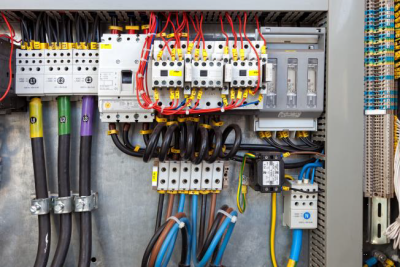
Electrical panels and junction boxes are everywhere—at home, at work, on ships, in vehicles, and on digital signage by the side of the road. The risk of corrosion—which could lead to premature failure of electrical systems—increases in the presence of moisture, chlorides, and corrosive gases. For example, electrical components that sit outdoors, exposed to precipitation or harsh marine environments, are more likely to corrode than those that sit in a cool, dry warehouse. Electricals in harsh industrial atmospheres indoors are also at higher risk. Protecting electrical components from corrosion is a practical way to extend electrical service life and minimize the amount of repair, replacement, or downtime caused by corrosion. One way this could be done is through the use of corrosion resistant materials, which unfortunately can be prohibitively expensive and are not fail-safe in the most extreme environments.
Cortec VpCI Technology offers practical, cost-effective alternatives to help protect existing electrical assets from corrosion and extend service life in three easy steps: Emit, Spray, Absorb.
Electricals inside a junction box or other enclosure can be easily protected by placing a self-stick VpCI-105 or VpCI-111 emitter cup inside the box. These cups function based on Vapor phase Corrosion Inhibitor Technology, emitting corrosion inhibiting vapors through a breathable membrane. The protective vapors disperse throughout the enclosure and are attracted to metal surfaces, even in hard to reach areas, where they adhere and form an invisible protective molecular layer that does not interfere with electrical operations. The molecular layer does, however, interfere with the ability of moisture, oxygen and other corrosives to start a corrosion cell on the metal. If the junction box is temporarily opened for servicing, allowing some of the vapors to escape, the protective layer will soon replenish itself after the box has been re-closed.
Electricals open to the environment or in enclosures with a significant amount of airflow can be protected by spraying on a thin film forming corrosion inhibitor such as ElectriCorr VpCI-238 or ElectriCorr VpCI-239. ElectriCorr VpCI-238 is recommended for indoor protection. ElectriCorr VpCI-239 provides heavier duty protection for harsher outdoor environments by leaving a fast-drying, non-sticky corrosion inhibiting film on components. Both ElectriCorr sprays are free of CFCs and 1,1,1-Trichloroethane. They can be safely applied for the corrosion protection of electronic circuits or relays without causing any significant changes in conductivity. They can also be sprayed on circuit boards and electrical contacts, such as those in digital billboards subject to harsh outdoor conditions and moisture ingress.
A third strategy can be used to reduce the overall amount of corrosive gases in extreme environments such as paper mills and wastewater treatment plants, where H2S is a common byproduct. Cortec Corrosorber cups absorb H2S and other corrosive gases, changing color from off-white to gray to black when the absorbent material is spent. Corrosorber cups can be used alone or, if desired, placed inside electrical panel boxes along with VpCI emitters as dual protection against corrosion.Easy. Important.Often, small maintenance steps along the way can make a big difference in saving time and expense in the long run, if only someone stops to take the time to do them. These three VpCI strategies are simple to implement but can play an important role in extending the service life of electricals by mitigating corrosion in harsh conditions. The solution may be as easy as sticking a VpCI-105 emitter in an electrical box, spraying an exposed outdoor electrical component with ElectriCorr VpCI-239, or placing Corrosorber cups in strategic areas around the industrial plant to minimize H2S. Simple actions like these performed as routine maintenance in the present can make it easier to avoid the need to replace corroded wiring or suffer from an electrical outage in the future.

